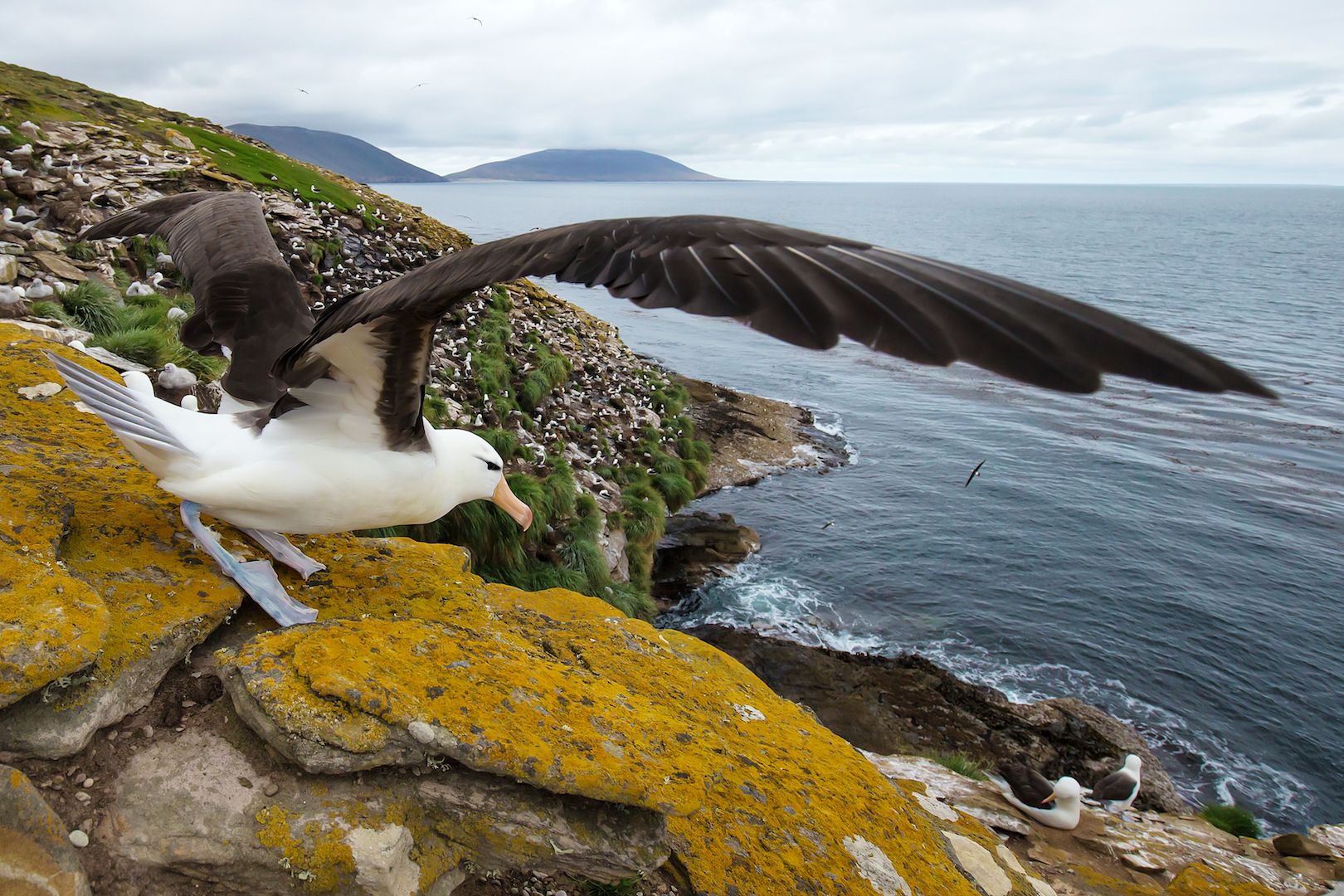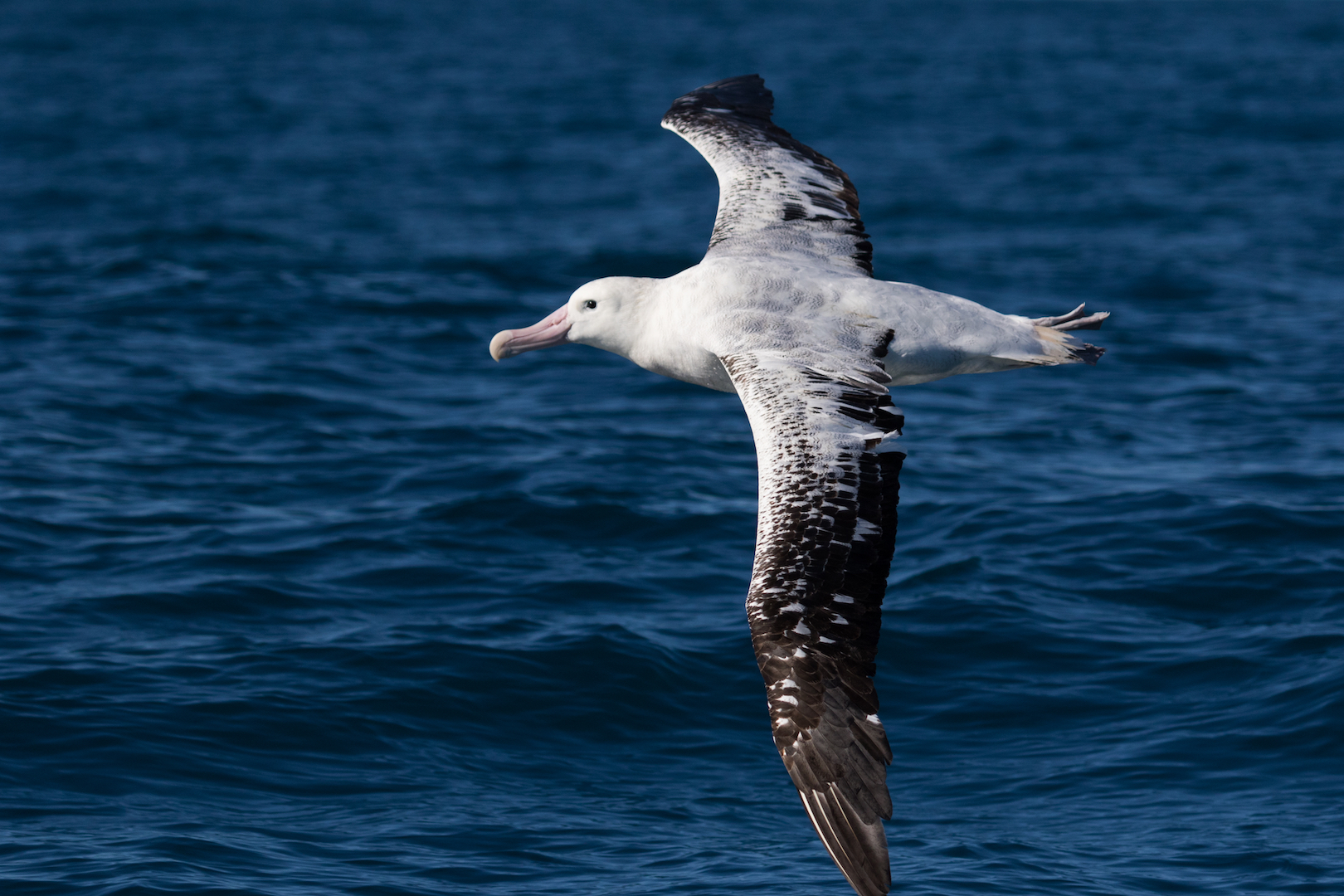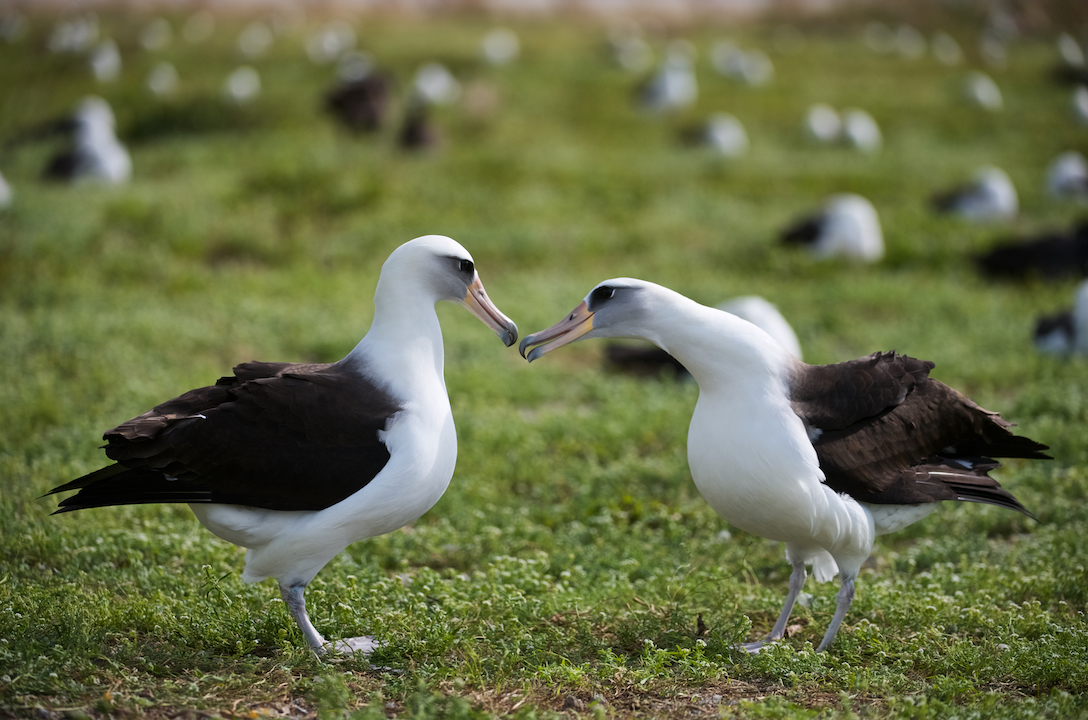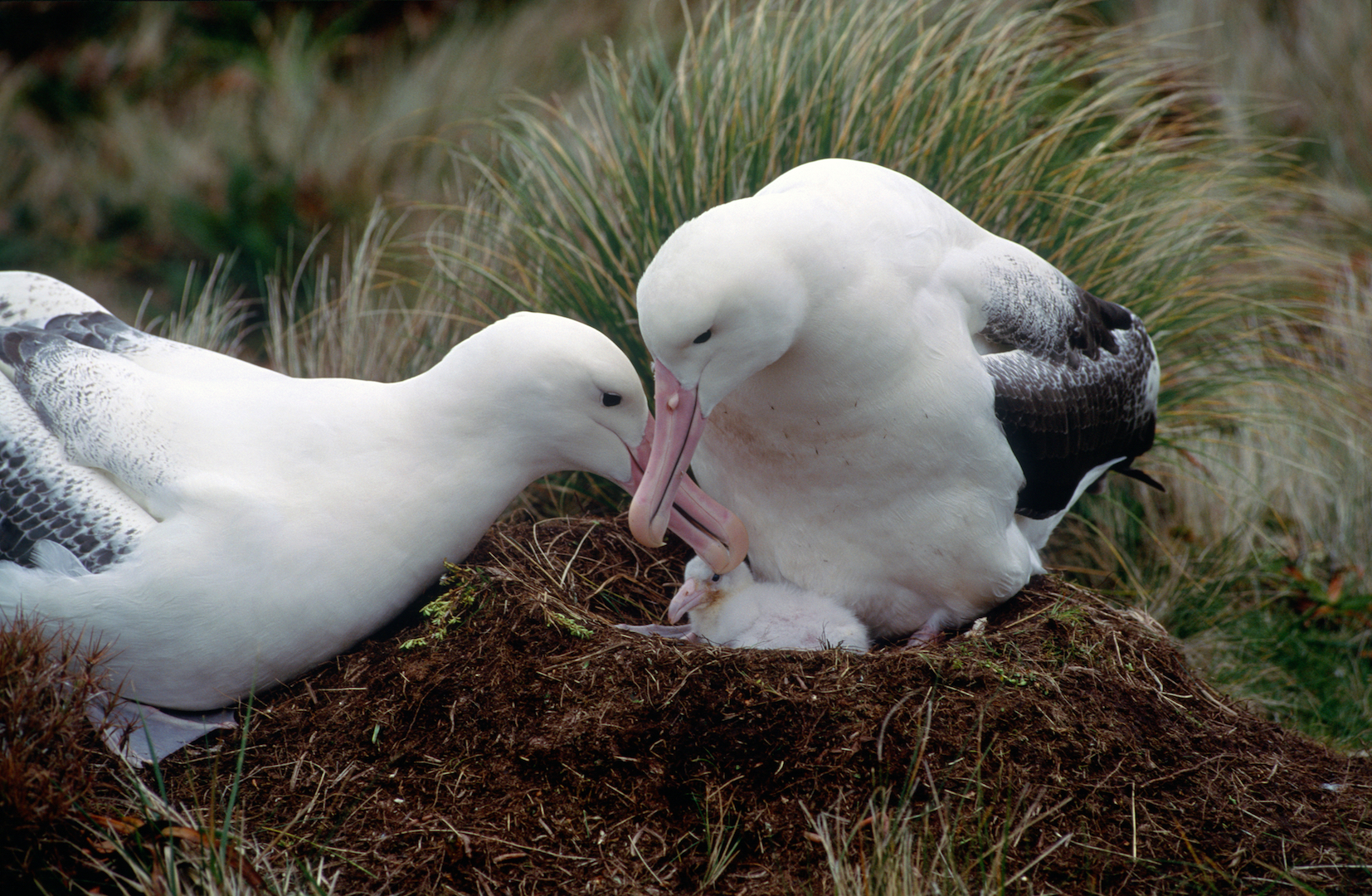Albatrosses: Facts about the biggest flying birds
The biggest flying bird in the world can go for years without touching land, has complicated, comical mating dances that take years to learn, and might even help scientists track down illegal fishing vessels.

Albatrosses are big, majestic birds that can be found soaring above most of the world’s oceans.
These frequent fliers are known for spending months in the air without touching down, as well as having some unique mating arrangements. However, thanks to harmful fishing techniques and predation by invasive species, albatrosses around the world are either under threat or endangered.
There are 23 species of albatrosses, though arguably the most famous is the wandering albatross (Diomedea exulans), which is the largest flying bird in the world. This bird has a 11-foot (3.4 meter) wingspan, according to the Encyclopedia Britannica — even bigger than the famous California condor — and it uses those massive flappers to travel thousands of miles in a single journey.
Related: Your dumb party balloons are killing all the seabirds
A life in the air
But rather than flapping its wings, wandering albatrosses (and many other large albatrosses) travel such far distances by holding their extended wings in place so that the air rushing around the wings generates lift, similar to an airplane's wings. An airplane forces air over its wings with an engine, whereas albatross take advantage of the extremely windy latitudes in the southern oceans.
This latitude range is "called the 'roaring 40s' and 'furious 50s' for a reason," said Andrea Angel, the Albatross Task Force manager with Birdlife South Africa, a nonprofit organization dedicated to bird conservation. With near constant wind in their environment, albatrosses are able to "lock their elbow joints and literally just fix their wings [in place] and just glide," Angel said. The birds also use something called "dynamic soaring," which involves changing the angle of their wings relative to the wind, to maximize the lift generated — a similar technique could help unmanned research aircraft stay aloft for months, the Independent reported.
Related: A hot blob in the Pacific Ocean caused 1 million seabirds to die
An albatross can go a year or more without setting foot on land, Angel said, although the birds do touch down in water in order to feed on the squid and fish that make up their diet. In fact, it's the tiny alpine swift, not the albatross, that holds the record for non-stop distance flying, as reported in a 2013 study published in the journal Nature Communications.
As for sleep, Angel said that it's very likely that albatrosses sleep on the wing. A 2016 study published in Nature Communications described how a distant cousin of the albatross, the frigatebird, has many, seconds-long periods of sleep while flying, suggesting that sleeping in the air is definitely possible for other long-distance traveling seabirds. And, based on microchip-tracked movements of albatrosses, "they can [fly] for hours on end, and so it is theorized that they do sleep on the wing," Angel said. "It's an accepted fact [that] because of their movements, they have to sleep."

All albatrosses are very long-lived. The oldest wild bird in the world is a Laysan albatross (Phoebastria immutabilis) named Wisdom, who was tagged in 1956 at the Laysan albatross colony at Midway Atoll in the North Pacific Ocean when she was already a mature adult. That makes her at least 66 years old, but she's likely older, and she's still going strong — as of 2018 she was still raising chicks, NPR reported. According to Breck Tyler, a lecturer at the University of California, Santa Cruz and retired research scientist who studied the Laysan albatross colony on Midway Atoll for decades, there are other Laysan albatrosses just a few years younger than Wisdom, so "she's probably not an outlier."
Related: World's oldest wild breeding bird is expecting her 41st chick
Although they're seabirds, albatrosses are generally poor divers, with few exceptions. The wandering albatross can only dive about 2 to 3 feet (0.6 to 1 m) into the ocean, yet based on an analysis of its diet, scientists are pretty sure the wandering albatross eats squid that live deeper in the water, and are too big for an albatross to convincingly take down. It's possible the large bird just waits until a squid swims up to the surface, but a more convincing hypothesis is that the birds are actually eating squid bits that have been vomited up by whales, as described in a 1994 study published in the journal Antarctic Science.
After a meal of whale upchuck, an albatross might wash that down with some refreshing seawater. All seabirds have a gland above their eyes that functions like a miniature kidney, allowing them to drink salt water and excrete it through the tip of their beak, according to the Travis Audubon Society.
Albatrosses mate for life, but aren't exclusive
Because albatrosses mate for life, picking the right partner is a major decision. All species of albatross have some sort of complicated mating dance. For the Laysan albatross, the dance has 24 separate, complex steps, and it takes years for males to learn them all, Tyler said. And until the young males can master the choreography, they won't find a mate, he said. The females can afford to be picky, so if a male's sequence of honks, whistles, wiggles and neck thrusts doesn't impress her, she'll just move on to the next suitor.

But once a pair does form, the "divorce rate" of albatrosses is among the lowest in the animal kingdom, and because albatrosses are so long-lived, these pairs can persist for decades. For this reason, it's been posited that albatrosses are the "most romantic" bird. But that human characterization ignores some key facts about albatrosses, Tyler said.
An albatross mating pair only sees each other a few days a year, when they meet at their breeding grounds. After a few days of catching up, the pair takes turns incubating the egg; one stays behind while the other forages for food. After about 90 days, and when the chick is big enough, the mating pair go their separate ways for the rest of the year, according to the Cornell Lab’s All About Birds.
Related: Adorable photos of baby shorebirds
Although they mate for life, albatross pairs aren't exclusive. Casual sex between non-paired birds, and even forced copulation, is not uncommon, the New York Times reported in 2010. A 2006 study published in the journal IBIS found that out of 75 wandering albatross couples, about eight had chicks that weren't fathered by their mother's primary mate.
And in many albatross species, female-female pairs are quite common (so far, male-male pairs haven't been reported), as Live Science has previously reported. Those females rely on "cheating" paired males or unpaired males to fertilize their eggs, and then the two females raise a clutch of two eggs together, without a male's involvement, the Times reported. Laysan albatross males and females look virtually identical, so unless you were specifically looking for evidence of same-sex pairs, you'd likely miss them, the Times said — and it's likely that many other species of birds, especially if there aren't enough males to go around, form similar pair bonds, Tyler said.

Threats to albatrosses
All but one species of albatross are either threatened, endangered or likely to become so, according to the International Union for the Conservation of Nature. The biggest threats are invasive species at the birds' nesting grounds, and fishing vessels, which unintentionally snare birds when they're pursuing tuna and other commercial fish, Angel said.
Many of the world's albatrosses nest on islands that were once used as whaling vessel stopovers, Angel explained. With the human ships came cats and rats and mice. Gough Island in the South Atlantic, for example, is one of the most important seabird colonies, home to 24 different species of birds and multiple types of albatross. But the colony is gruesomely preyed upon by invasive mice that have evolved to be a much larger than normal size without the presence of predators, Hakai magazine reported.
Perhaps because they have no other predators that would attack them this way, Albatross have not evolved a way to defend themselves against a mouse attack, and so some of the adults sit motionless, letting "the mice nibble on their flesh while they steadfastly incubate their egg." On a number of important bird islands, conservationists are launching aggressive mouse-eradication programs to attempt to save the remaining birds, National Geographic reported.
Related: In photos: Mice brutally attack and devour albatross on Gough Island
At sea, albatrosses face a different threat: fishing vessels. Albatrosses are pretty good at detecting fishing vessels — so good that researchers think the birds, outfitted with tiny radar detectors, could be used to find boats operating illegally, The New York Times reported.
Large fishing vessels have onboard processing facilities where fish heads and tails and guts are removed and dumped back into the sea, which attracts all sorts of seabirds. "It is a seabird spectacle," Angel said. But as the trawler is dumping fish guts, it's simultaneously dropping the giant fishing net back into the ocean for the next catch. Seabirds, including albatrosses, get entangled in the net cables and dragged under water, then drown. And longline fishing boats, in which a 30-mile-long (48 kilometer) floating fishing line is set with hundreds of baited hooks, also attract seabirds which see the enticing meal from the surface, but get caught on the hooks and drown.
BirdLife South Africa has reduced albatross deaths in the local trawl fishery by 99% by simply encouraging boats to use bird-scaring streamers and shifting the time that the boats dump out the fish waste to after the net is set. But worldwide there's still much more work to be done when it comes to encouraging commercial fishers to practice more seabird-friendly fishing techniques.
Additional resources:
- Learn more about the relationship between birds and humans on Midway Atoll with this feature from American Bird Conservancy
- Watch a Laysan albatross perform its complicated (and comical) mating dance.
- View not-quite-live-cam shots of albatrosses on Bird Island near the Antarctic Circle on BirdLife International’s Facebook page.
Sign up for the Live Science daily newsletter now
Get the world’s most fascinating discoveries delivered straight to your inbox.
Rachel is a writer and editor based in Washington, D.C., who covers a range of topics for Live Science, from animals and global warming to technology and human behavior. Rachel also contributes to National Geographic News, Smithsonian Magazine and Scientific American, and she is currently a senior editor at Next City, a national urban affairs magazine. She has an English degree with a journalism concentration from Adelphi University in New York.











